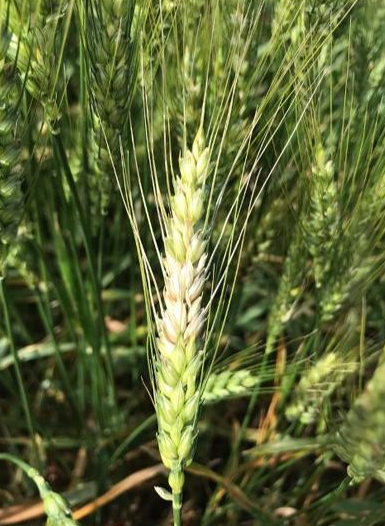
Fusarium head blight (head scab) is most common in eastern and central Kansas. The disease is rare in western Kansas, where dry conditions generally suppress disease development. However, it has shown up in many fields this week in our area and I am hearing further west as well.
Some quick facts about Fusarium head blight
· Symptoms of head scab include one or more spikelets that have become tan or bleached in color, while the stem typically remains green. In some cases, pinkish-orange structures of the fungus are also visible on infected spikelets. Symptoms can be quickly masked by maturity and may be easily missed.
· The disease damages the grain directly, with infected kernels appearing white and chalky. Some kernels have a pink discoloration.
· The fungus that causes Fusarium head blight survives in the residues of corn, wheat, barley, oats, and many wild grasses. Infection takes place during flowering or early stages of grain development and is favored by damp weather.
· No single management option provides high levels of disease control; therefore, the disease is best managed with a combination of genetic resistance and fungicides.
· Disease losses can be reduced by harvesting fields with the lowest disease levels first, adjusting harvest equipment to remove diseased kernels, and segregating loads of healthy and diseased grain.
The life cycle of the fungus that causes Fusarium head blight, survives in the residues of previously grown crops. The fungus reproduces on these residues during periods of wet weather, with spores moved by wind or splashing rain to developing wheat heads. Planting wheat in fields with large amounts of corn or wheat residue often increases the risk of disease. Wheat is most vulnerable to infection during flowering and early stages of grain development. The disease is most likely to develop when temperatures are between 65 and 80 Fahrenheit; frequent rainfall creates extended periods of high relative humidity, which favors disease reproduction and infection during these growth stages.
Fusarium head blight is a difficult disease to manage, and no single management option provides high levels of disease control. Therefore, the disease is best managed with a combination of genetic resistance and fungicides. A fungicide application to control head scab must be made during flowering, before symptoms are present. When symptoms are visible, a fungicide will no longer be effective for control.
For further information on Fusarium head blight (head scab) you can view a publication produced by the Plant Pathology Department and K-State Research & Extension on our web site at www.cottonwood.ksu.edu click onto the Crops and Livestock tab and look under Hot Topics section.




